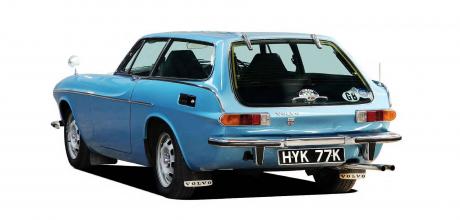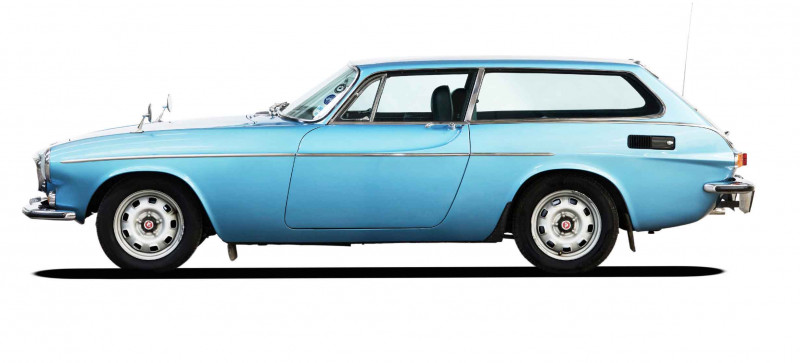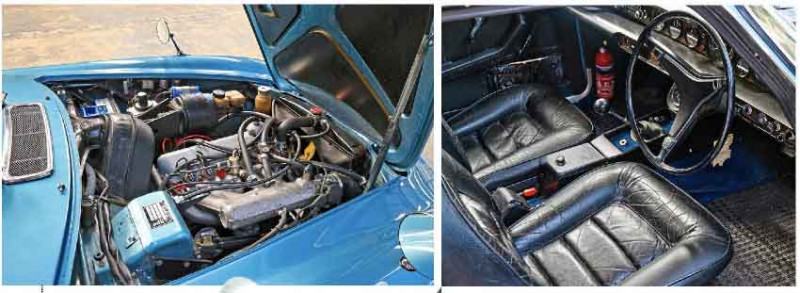Buying Guide Volvo 1800-series

Buy wisely and a classic bargain with cult-TV cool could be yours for as little as £10k.
Words CHRIS RANDALL
Photography MATT HOWELL
Get style, dodge the risks — Buy yourself Volvo’s classy and usable 1800 from as little as £10k
Buying Guide Get yourself into an iconic Volvo 1800-series for as little as £10,000

Icons don’t come much more usable than Volvo’s 1800-series. Although The Saintreferencing early P1800 coupés in resale white can fetch big sums, the later examples have just as much visual appeal, are arguably better to drive – and this being a Volvo, there’s even a handy estate version.
They aren’t £5k classics any more though – at least, not if you want one that doesn’t need restoration. However, £10k for a solid runner that makes you look like a Sixties international man of mystery is a snip compared to the £500k a reasonable Aston Martin DB5 will set you back. Specialists aren’t exactly abundant though, and tough as these Volvos are, renovation costs can rapidly mount up if – and you might struggle to recoup them when selling, depending on model. With this in mind, we called upon Simon Richardson of Brookhouse Classic Volvo to help guide you towards a great 1800.

Which one to choose?
- Styled by Swede Pelle Petterson under the guidance of Pietro Frua, the 1.8-litre four-cylinder Volvo P1800 was designed in 1957 as a replacement for the illfated glassfibre-bodied P1900 sports car. Production needed to be outsourced, but after Karmann snubbed Volvo in favour of Volkswagen, Jensen was chosen to build the early bodyshells instead. These first examples were built in 1960.
- After experiencing quality issues with Jensen, Volvo took production in-house from 1963, renaming it 1800S (for Sweden). Overdrive became an option, power rose by 8bhp to 108bhp, and a restyle replaced the angled bumpers with straight ones.
- For the 1969 model year, the 1800S received a new 2.0-litre engine with 118bhp, although the model name remained unchanged.
- An 1800E (‘Einspritzung’, German for ‘injection’) replaced the 1800S in 1970. Black-grilled restyle accompanied four-wheel disc brakes and Bosch D-Jetronic fuel injection, which contributed to its 130bhp. Coupé discontinued in 1972.
- Shooting-brake 1800ES launched to accompany the 1800E coupé in 1972, but soon replaced it. Engine detuned to 125bhp for smoother performance, auto’ gearbox was an option. Discontinued late 1973.
Engine and gearbox
The 1800’s engines are robust and proper maintenance can see them pass 200,000 miles with ease – the all-time world mileage record is held by an 1800S. Check the service history though: oil and filter changes every 6000 miles or annually is key to longevity. Otherwise it’s a matter of checking for the usual signs of wear and tear, such as knocks, rumbles and exhaust smoke, the latter most likely to be from worn valve stem oil seals if it occurs on the overrun and cold starts. Camshafts can wear, too, and listen for noises from the timing gear, which uses both fibre and steel gears – budget £198 plus a few hours’ labour to fit if it needs replacing. Poor running could be down to carburettors in need of an overhaul and although the Bosch injection system is reliable, any issues will need specialist attention.
It’s rare that these strong engines need a complete rebuild, and thankfully they are common to the Volvo ‘Amazon’ saloon range from which the 1800-series was derived. With this in mind, if an engine is in need of a rebuild and matching numbers aren’t important to you, sourcing a replacement unit is likely to be a better solution. Budget £1000 to buy one and the same again to get it fitted.
The manual gearboxes are strong. It’s unusual to find a P1800 in the UK without overdrive but bear in mind that so-equipped gearboxes use engine oil, not gear oil. The Borg Warner automatic isn’t common but broadly reliable so focus on the quality of the gear changes during a test drive.
The rear axle is similarly strong but check for oil escaping from worn half-shaft and pinion shaft seals; replacement isn’t difficult, though.
Bodywork
Discovering significant corrosion is the biggest risk when assessing a P1800 because major restoration is a costly undertaking. Start with the front wings around the head and side lamps and the splash panel at the rear; the box section beneath contains foam and the top edge often rots out.
Front wing replacement costs £714 for parts alone even before fitting and painting is factored in, and requires windscreen removal to fit. The three-piece sills are another key check – replacement of these is a complex task and requires the bottoms of the wings to be cut off, leading to wing replacement or repair. Is the vertical seam at each end of the sill panel beneath the doors still visible or have they disappeared during incorrect replacement? Rear wings corrode at their extremities, too.
More rust checks include the door bottoms and frames, the bonnet and boot panels and the valances. Bonnet hinges can seize, too, resulting in damage to the inner and outer skins. Floors and chassis sections/outriggers also require careful scrutiny, with particular attention to the front crossmember beneath the radiator. All of this also applies to the ES but remember to check the tailgate and rear roof pillars on those. The quality and accuracy of previous restorations is important; panel fit can differ between cars and fettling can be required for things to fit properly. And examine the brightwork – replacements are rare and pricey.
The Swedish-built 1800s are tough cars, but bear in mind that restoring a thoroughly rotten one will probably top £50,000 – a sum you only stand a chance of recouping on an early P1800 with excellent provenance. With this in mind, an example in need of the odd localised repair is a good bet if you’re after a scruffy 1800, but a barn find is likely be bad news unless the bodywork is rust-free or you’re sufficiently skilled to restore it yourself.
Suspension, steering and brakes
The P1800’s suspension design is conventional so just carry out a bounce test to ensure that coil springs and dampers aren’t due for replacement. Wishbone bushes last reasonably well but replacing them isn’t difficult and you can go with original items or swap to polyurethane components as part of a handling-improvement programme. It’s also advisable to have a good prod around mounting points to make sure that corrosion hasn’t begun to take hold.
The steering should feel pleasantly light on the move so heaviness will need investigating; it could be that a worn steering box has been over-adjusted but with new ones unavailable you’re looking at a specialist rebuild or a second-hand unit. Look for any rot around its mountings, too.
The P1800’s handling never quite lived up to the sporty looks, something often attributed to soft spring and damper ratings. A set of Bilstein dampers for £100 a corner can sharpen it up no end. Rear disc brakes were fitted as standard from 1970; it was the usual combination of discs and drums with either single- or dual-circuit hydraulics prior to that. While there’s nothing complicated about the arrangement you’ll want to make sure that everything’s in good order, with particular attention paid to signs of corrosion and seized parts on little-used cars. It’s also important to check the operation of the servo because replacements cost more than £300. The good news is that consumables are easy and cheap to source, although DIY-proficient owners should note that a special hub-puller is needed to remove the rear drums.
Interior
The P1800’s cabin materials stand up well to use, and general simplicity means that wear and damage will be obvious – it’s a case of budgeting accordingly if renovation is needed.
Replacement carpets and seat covers are easy to get hold of and cost around £350 apiece; and while some smaller trim items are no longer available, plenty of larger parts still are. In any case, it’s far better to buy a P1800 with a scruffy cabin than one in need of extensive bodywork restoration.
Lastly, there’s the electrics to check and aside from age-related issues it’s an area that thankfully is rarely troublesome – ensuring that all of the gauges are working is the main thing.
Never the sharpest of handlers, but easily addressed with upgrades. Solid, reliable and cool – so long as you avoid a restoration project. Two engines were used, with injection arriving in 1970. Despite cool shootingbrake form, the ES is the entry point to 1800 ownership.
What to pay
- Drivable higher-mileage 1800ESs start at £10,000; projects cost less but won’t be economical to restore. Mint restored low-milers can make £25,000.
- 1800S and 1800E coupés can be found from £12,000, up to £35,000 for the best.
- Despite quality issues when new, the Jensen-built P1800s are most desirable, especially in white. Pay £20,000 for an average example and up to £40,000 for a perfect one; possibly even more if it can be proven it was one of the fleet used when filming The Saint.
They aren’t £5k classics any more – at least not if you want one that doesn’t need restoration’
Owning a Volvo 1800
Neil Murray
Attending Volvo Owners’ Club rallies with his dad gave Neil a taste for the 1800 at a young age. And having already restored one he couldn’t resist this superb 1970 example. He says, ‘I’d sold my previous car and wasn’t really looking for another when this one popped up. That was in 2011 and discovering that it had had just two owners, was in completely original condition and had covered just 20,000 miles got me properly excited. There aren’t many like that around, so it was too good an opportunity to miss.
‘It’s needed just one small rust repair to a front wing and I’ve painted the engine bay, but otherwise the body and paintwork have remained largely original. And mechanically it’s only required general maintenance and some new rear axle seals. It admittedly doesn’t get much use because I want to keep the mileage low, but I do enjoy occasional drives and going to events.’
Graham Wilson
‘My parents had a number of Amazon models when I was growing up – although I do remember my dad coming home one day in an 1800 coupé, much to my mother’s horror,’ recalls Graham Wilson. ‘We were still very much a family of four, so it went straight back to the dealership!
‘My ES was originally bought by a firm of accountants and later sold on to a friend of mine. John then ended up with a company car, so parked the Volvo in his mother’s garage in Hitchin, where it stayed for many years. I had no idea about it until one day in the Eighties, he mentioned that he needed to move ‘his old car’. I couldn’t believe it when he opened the garage! We trailered it to the garage of his house in Northamptonshire where it remained until 2000, when he agreed to sell it to me.
‘It was very straight but it needed quite a refurb! The fuel injection system was all clogged up, while the bumpers, seats and other trim was off the car. To reassemble it though, I spent a long while going around shows to take pictures of other examples.
‘The engine has been brilliant – aside from one head gasket failure – while I’ve re-chromed the three-piece bumpers and replaced the exhaust, springs, dampers, radiator and alternator. That said, there was one particularly hairy experience when one of the fuel lines broke on the King Harry ferry in Cornwall – the crew was furious and shoved us off the ferry with some urgency. I replaced the whole fuel system after that!
‘It isn’t fast, but it’s comfortable and makes a fine tourer. We took it to the Le Mans Classic and my wife Janet paid for us to do a few laps. It’s unlikely I’d sell it, because there’s really nothing else out there that does quite as much as an 1800ES. And you don’t often see them at the supermarket!’
VOLVO P1800ES — £37,750
One owner until 2019.
Complete history, 122,000 miles.
First registered on 24 June 1972 and delivered locally by Volvo dealership Hansons (East Parade) Ltd of Harrogate, Yorkshire as attested by the original service booklet. All service works were always entrusted to Hansons; the service book is stamped up to the hilt. Bodywork restored using original Volvo parts (no longer available) in 1992. The exterior was still in excellent condition when it was sold in 2019 although the completely original interior needed only a slight refurbish, so the seats were removed, new foams were fitted and the covers cleaned and repaired before the interior was put back. Recently fitted with power steering so now extremely easy to drive. The electric fuel injection provides a perky engine note and the electronic overdrive gives smooth and comfortable cruising. Pretty and practical – can store golf clubs, shotguns and fishing equipment all at the same time.

